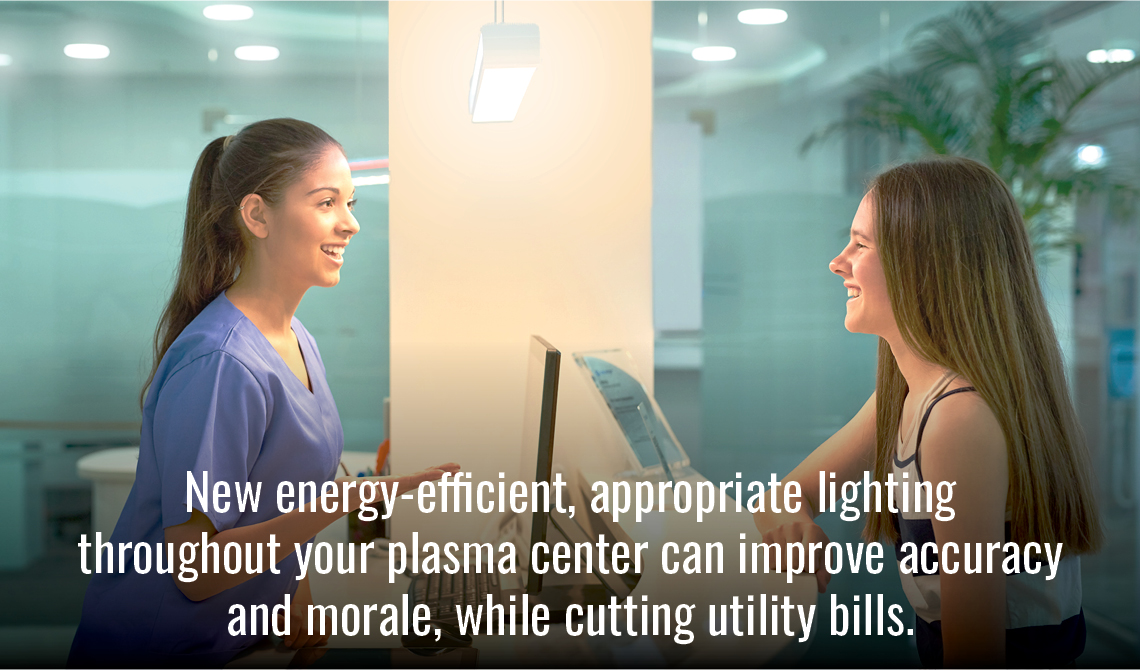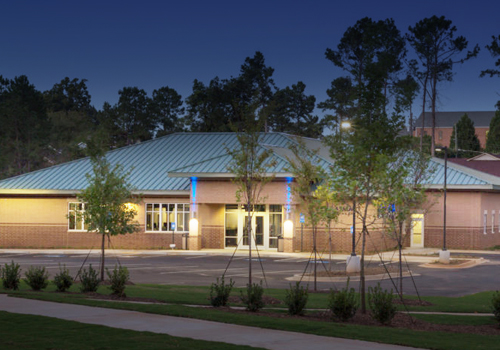
An often-overlooked aspect of plasma center success is lighting. The right lighting can improve accuracy, create a more pleasant environment, and reduce the time needed for each donation.
Bright ideas for your center:
Through the experience of designing, building and running a wide range of plasma center facilities, Stough Group has developed a streamlined system for choosing center lighting that improves productivity.
Call today to learn more about Stough’s turnkey plasma center solutions.
1. Technology is your friend
New lighting technologies such as halogen lights are long-lasting and energy-efficient. They can cut your energy bills, while providing warm, color-true lighting. Fluorescents, which are less efficient and make everything green, are on the way out.
Back To Top
2. Calming light
Natural light has a calming effect, and research has documented that employees who work in natural light are happier and take fewer sick days. In the bad old days of plasma centers, owners would simply put plywood over broken windows and not consider the impact on donors and employees. While there is still not enough consciousness about natural light in the plasma collection business, the trend is toward productivity-enhancing natural light. Stough Group installs large, light-gathering windows to provide natural light inside each of our plasma centers.
Where there’s insufficient daylight, use new energy-efficient technologies that replicate natural light conditions.
Back To Top3. Invest in better lighting and cut your utility bill
Overall, lighting should be flexible and energy-efficient. Upgrading to new technologies can seem pricy, but monies saved in employee productivity and energy use more than make up for initial costs. LEDs (light-emitting diodes) last longer, reduce maintenance, save energy and cut utility bills.
Back To Top
4. Considerations for lighting various parts of your plasma center:
Exterior/parking — The parking lot is the donor’s first impression of your center. A poorly-lit parking lot could drive potential donors away if they don’t feel safe. A well-lit area is welcoming, prevents accidents and puts donors and employees at ease. Some things to keep in mind for this area include: patterns with unlit patches, correct foot candles, height of light poles, vibration-activated lights, dark-sky compliance, local codes, color temperature, visual comfort and glare control.
To amortize improved outdoor lighting costs, consider staying open earlier and later. This way people with jobs can find a convenient time to donate plasma. We call it the Walmart Concept: stay open more hours, light the parking lot well at all times, and you will attract more women and a healthier donor panel.
Front entry – A well-lit entry helps highlight the design of the interior, and directs donors where to go. Consider correct lumen packages, comfortable lighting and glare control.
Reception — In this area, you don’t want the light too bright. As well as welcoming, the light should clearly guide the donor’s path. The lighting should be relaxing, comforting and warm, yet there should also be adequate lumination for employees to collect and record information.
Phlebotomy ward—Donors on beds are looking up, so indirect lighting is needed. It should be warm and comforting, but also bright enough for the medical staff to perform their work accurately. With decades of developing lighting plans for plasma centers, we have figured out how to accomplish both. A low UGR (Unified Glare Rating) on the fixtures is a good idea.
Offices – Here you want correct lighting for paperwork and computer work. Along with computer task lighting, try to replicate natural light here, with an average of 35-40 foot candles at the work surface. Avoid creating hot spots or low light areas.
Conference rooms – Flexibility and a good control system are important because different tasks are done in this room: notetaking, live/video presentations and conversations. You want to be able to control the lighting easily and quickly.
Without adequate light, people become tired, develop headaches, strain their eyes and lose concentration. When it is sufficient, everyone feels better, the space is attractive, and more work gets done.
Overhead lighting is important. Wall washers or spotlights can also be used to highlight certain areas. 40-50 foot-candles is the norm. A Stough standard is downlights, with a decorative linear light or troffers (rectangular light fixtures that fit into the dropped-ceiling grid) over the table.
Doctor offices/exam rooms – Indirect lighting should be used to prevent glare, along with task lighting and table lamps. Adequate light helps prevent errors. Warm light puts donors at ease.
Plasma processing – This area demands good light of 45-60 foot candles. There typically are not windows here, so incorporate “day lights” if possible.
Back To TopAlong with selecting finishes that are aesthetically pleasing, cleanable and durable, the Stough Interior Design team works with our plasma clients to make lighting decisions that meet their individual needs.
WITH STOUGH GROUP, YOU DON’T HAVE TO SWEAT LIGHTING DETAILS; WE SWEAT THEM FOR YOU.
Reach Us
To streamline delivery and control costs, we take a prototype approach when possible, engage local civil engineering consultants for each project, and establish a working relationship with the local governing authority.